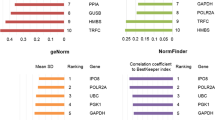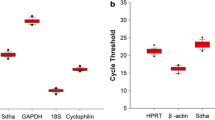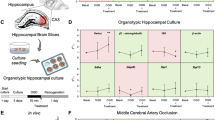Abstract
Adaptation to chronic hypoxia renders the heart more tolerant to ischemia/reperfusion injury. To evaluate changes in gene expression after adaptation to chronic hypoxia by RT-qPCR, it is essential to select suitable reference genes. In a chronically hypoxic rat model, no specific reference genes have been identified in the myocardium. This study aimed to select the best reference genes in the left (LV) and right (RV) ventricles of chronically hypoxic and normoxic rats. Sprague–Dawley rats were adapted to continuous normobaric hypoxia (CNH; 12% O2 or 10% O2) for 3 weeks. The expression levels of candidate genes were assessed by RT-qPCR. The stability of genes was evaluated by NormFinder, geNorm and BestKeeper algorithms. The best five reference genes in the LV were Top1, Nupl2, Rplp1, Ywhaz, Hprt1 for the milder CNH and Top1, Ywhaz, Sdha, Nupl2, Tomm22 for the stronger CNH. In the RV, the top five genes were Hprt1, Nupl2, Gapdh, Top1, Rplp1 for the milder CNH and Tomm22, Gapdh, Hprt1, Nupl2, Top1 for the stronger CNH. This study provides validation of reference genes in LV and RV of CNH rats and shows that suitable reference genes differ in the two ventricles and depend on experimental protocol.


Similar content being viewed by others
References
World Health Organization (2018) The top 10 causes of death. World Health Organization. https://www.who.int/news-room/fact-sheets/detail/the-top-10-causes-of-death. Accessed 17 December 2018
Neckar J, Ostadal B, Kolar F (2004) Myocardial infarct size-limiting effect of chronic hypoxia persists for five weeks of normoxic recovery. Physiol Res 53:621–628
Kolar F, Ostadal B (2004) Molecular mechanisms of cardiac protection by adaptation to chronic hypoxia. Physiol Res 53:S3–13
Ostadal B, Kolar F (2007) Cardiac adaptation to chronic high-altitude hypoxia: beneficial and adverse effects. Respir Physiol Neurobiol 158:224–236
Julian GS, Oliveira RW, Tufik S, Chagas JR (2016) Analysis of the stability of housekeeping gene expression in the left cardiac ventricle of rats submitted to chronic intermittent hypoxia. J Bras Pneumol 42:211–214
Schmittgen TD, Livak KJ (2008) Analyzing real-time PCR data by the comparative C(T) method. Nat Protoc 3:1101–1108
Bustin SA, Benes V, Garson JA, Hellemans J, Huggett J, Kubista M, Mueller R, Nolan T, Pfaffl MW, Shipley GL, Vandesompele J, Wittwer CT (2009) The MIQE guidelines: minimum information for publication of quantitative real-time PCR experiments. Clin Chem 55:611–622
Vandesompele J, De Preter K, Pattyn F, Poppe B, Van Roy N, De Paepe A, Speleman F (2002) Accurate normalization of real-time quantitative RT-PCR data by geometric averaging of multiple internal control genes. Genome Biol 3:research0034.1–0034.11
Vesentini N, Barsanti C, Martino A, Kusmic C, Ripoli A, Rossi A, L’Abbate A (2012) Selection of reference genes in different myocardial regions of an in vivo ischemia/reperfusion rat model for normalization of antioxidant gene expression. BMC Res Notes 5:124
Caradec J, Sirab N, Keumeugni C, Moutereau S, Chimingqi M, Matar C, Revaud D, Bah M, Manivet P, Conti M, Loric S (2010) ‘Desperate house genes’: the dramatic example of hypoxia. Br J Cancer 102:1037–1043
Klenke S, Renckhoff K, Engler A, Peters J, Frey UH (2016) Easy-to-use strategy for reference gene selection in quantitative real-time PCR experiment. Naunyn Schmiedebergs Arch Pharmacol 389:1353–1366
Gubern C, Hurtado O, Rodriguez R, Morales JR, Romera VG, Moro MA, Lizasoain I, Serena J, Mallolas J (2009) Validation of housekeeping genes for quantitative real-time PCR in in vivo and in vitro models of cerebral ischaemia. BMC Mol Biol 10:57
Svingen T, Letting H, Hadrup N, Hass U, Vinggaard AM (2015) Selection of reference genes for quantitative RT-PCR (RT-qPCR) analysis of rat tissues under physiological and toxicological conditions. PeerJ 3:e855
Adeola F (2018) Normalization of gene expression by quantitative RT-PCR in human cell line: comparison of 12 endogenous reference genes. Ethiop J Health Sci 28:741–748
Andersen CL, Jensen JL, Orntoft TF (2004) Normalization of real-time quantitative reverse transcription-PCR data: a model-based variance estimation approach to identify genes suited for normalization, applied to bladder and colon cancer data sets. Cancer Res 64:5245–5250
Pfaffl MW, Tichopad A, Prgomet C, Neuvians TP (2004) Determination of stable housekeeping genes, differentially regulated target genes and sample integrity: BestKeeper—excel-based tool using pair-wise correlations. Biotechnol Lett 26:509–515
Kubista M, Rusnakova V, Svec D, Sogreen D, Tichopad A (2012) GenEx: data analysis software. In: Filion M (ed) Quantitative real-time PCR in applied microbiology, 1st edn. Caister Academic Press, Norfolk, pp 63–84
Molina CE, Jacquet E, Ponien P, Munoz-Guijosa C, Baczko I, Maier LS, Donzeau-Gouge P, Dobrev D, Fischmeister R, Garnier A (2018) Identification of optimal reference genes for transcriptomic analyses in normal and diseased human heart. Cardiovasc Res 114:247–258
Dengler VL, Galbraith M, Espinosa JM (2014) Transcriptional regulation by hypoxia inducible factors. Crit Rev Biochem Mol Biol 49:1–15
D’Ignazio L, Rocha S (2016) Hypoxia induced NF-κB. Cells 5:10
Kolamunne RT, Dias IH, Vernallis AB, Grant MM, Griffiths HR (2013) Nrf2 activation supports cell survival during hypoxia and hypoxia/reoxygenation in cardiomyoblasts; the roles of reactive oxygen and nitrogen species. Redox Biol 1:418–426
Kaluz S, Kaluzova M, Stanbridge EJ (2008) Regulation of gene expression by hypoxia: integration of the HIF-transduced hypoxic signal at the hypoxia-responsive element. Clin Chim Acta 395:6–13
Liu T, Lingyun Z, Joo D, Sun SC (2017) NF-κB signaling in inflammation. Signal Transduct Target Ther 2:e17023
Graven KK, Yu Q, Pan D, Roncarati JS, Farber HW (1999) Identification of an oxygen responsive enhancer element in the glyceraldehyde-3-phosphate dehydrogenase gene. Biochim Biophys Acta 1447:208–218
Wu J, Bond C, Chen P, Chen M, Li Y, Shohet RV, Wright G (2015) HIF-1α in the heart: remodeling nucleotide metabolism. J Mol Cell Cardiol 82:194–200
Brattelid T, Winer LH, Levy FO, Liestol K, Sejersted OM, Andersson KB (2010) Reference gene alternatives to Gapdh in rodent and human heart failure gene expression studies. BMC Mol Biol 11:22
Cabiati M, Raucci S, Caselli C, Guzzardi MA, D’Amico A, Prescimone T, Giannessi D, Del Ry S (2012) Tissue-specific selection of stable reference genes for real-time PCR normalization in an obese rat model. J Mol Endocrinol 48:251–260
Klusonova P, Rehakova L, Borchert G, Vagnerova K, Neckar J, Ergang P, Miksik I, Kolar F, Pacha J (2009) Chronic intermittent hypoxia induces 11β-hydroxysteroid dehydrogenase in rat heart. Endocrinology 150:4270–4277
Bohuslavova R, Kolar F, Kuthanova L, Neckar J, Tichopad A, Pavlinkova G (2010) Gene expression profiling of sex differences in HIF1-dependent adaptive cardiac responses to chronic hypoxia. J Appl Physiol 109:1195–1202
Perez S, Royo LJ, Astudillo A, Escudero D, Alvarez F, Rodriguez A, Gomez E, Otero J (2007) Identifying the most suitable endogenous control for determining gene expression in hearts from organ donors. BMC Mol Biol 8:114
Li M, Rao M, Chen K, Zhou J, Song J (2017) Selection of reference genes for gene expression studies in heart failure for left and right ventricles. Gene 620:30–35
Pillbrow AP, Ellmers LJ, Black MA, Moravec CS, Sweet WE, Troughton RW, Richards AM, Frampton CM, Cameron VA (2008) Genomic selection of reference genes for real-time PCR in human myocardium. BMC Med Genomics 1:64
Caselli C, D’Amico A, Caruso R, Cabiati M, Prescimone T, Cozzi L, Cannata A, Parodi O, Del Ry S, Giannessi D (2013) Impact of normalization strategy on cardiac expression of pro-inflammatory cytokines: evaluation of reference genes in different human myocardial regions after left ventricular assist device support. Cytokine 63:113–122
Nachar W, Busseuil D, Shi Y, Michalache-Avram T, Mecteau M, Rheaume E, Tardiff JC (2014) Optimisation of reference genes for gene-expression analysis in a rabbit model of left ventricular diastolic dysfunction. PLoS ONE 9:e89331
Martino A, Cabiati M, Campan M, Prescimone T, Minocci D, Caselli C, Rossi AM, Giannessi D, Del Ry S (2011) Selection of reference genes for normalization of real-time PCR data in minipig heart failure model and evaluation of TNF-α mRNA expression. J Biotechnol 153:92–99
Ruiz-Villalba A, Mattiotti A, Gunst QD, Cano-Ballesteros S, van den Hoff MJ, Ruijter JM (2017) Reference genes for gene expression studies in the mouse heart. Sci Rep 7:24
Everaert BR, Boulet GA, Timmermans JP, Vrints CJ (2011) Importance of suitable reference gene selection for quantitative real-time PCR: special reference to mouse myocardial infarction studies. PLoS ONE 6:e23793
Hellemans J, Mortier G, De Paepe A, Speleman F, Vandesompele J (2007) qBase relative quantification framework and software for management and automated analysis of real-time quantitative PCR data. Genome Biol 8:R19
Acknowledgements
This research was funded by CHARLES UNIVERSITY GRANT AGENCY, Grant Number 200317 and GRANT AGENCY OF THE CZECH REPUBLIC, Grant Numbers 16-12420Y and 19-04790Y. We kindly thank Dr. Matus Sotak for help with manuscript editing.
Author information
Authors and Affiliations
Corresponding author
Ethics declarations
Conflicts of interest
The authors declare no conflict of interest.
Ethical approval
The funders had no role in the design of the study; in the collection, analyses, or interpretation of data; in the writing of the manuscript, or in the decision to publish the results. All procedures have been performed in accordance with the ethical standards and with the approvement of the Ethical Committee of the Institute of Physiology CAS in Prague.
Additional information
Publisher's Note
Springer Nature remains neutral with regard to jurisdictional claims in published maps and institutional affiliations.
Rights and permissions
About this article
Cite this article
Benak, D., Sotakova-Kasparova, D., Neckar, J. et al. Selection of optimal reference genes for gene expression studies in chronically hypoxic rat heart. Mol Cell Biochem 461, 15–22 (2019). https://doi.org/10.1007/s11010-019-03584-x
Received:
Accepted:
Published:
Issue Date:
DOI: https://doi.org/10.1007/s11010-019-03584-x




